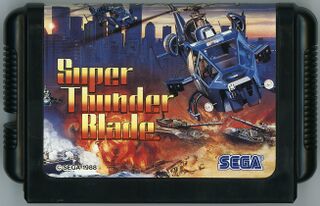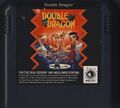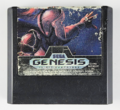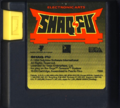Difference between revisions of "Mega Drive cartridges"
From Sega Retro
(→Technical information: Exists Mega Drive games (such as Art Alive!) that came in 1 megabit cartridges.) |
|||
| (38 intermediate revisions by 7 users not shown) | |||
| Line 1: | Line 1: | ||
| − | [[File:Superthunderblade md jp cart.jpg|320px|thumb|right|''[[Super Thunder Blade]]'' (Japanese version), the first commercially available [[Sega Mega Drive]] cartridge (alongside ''[[Space Harrier II]]'')]] | + | [[File:Superthunderblade md jp cart.jpg|320px|thumb|right|''[[Super Thunder Blade]]'' (Japanese version), the first commercially available [[Sega Mega Drive]] cartridge (alongside ''[[Space Harrier II]]'').]] |
'''{{PAGENAME}}''' are the primary storage medium for the [[Sega Mega Drive]]. | '''{{PAGENAME}}''' are the primary storage medium for the [[Sega Mega Drive]]. | ||
| Line 26: | Line 26: | ||
Cartridge designs for ''[[Altered Beast]]'' - though labels would change dramatically over the console's run, the physical shape would remain consistent. | Cartridge designs for ''[[Altered Beast]]'' - though labels would change dramatically over the console's run, the physical shape would remain consistent. | ||
| − | ==== | + | ====Alternate cartridge designs==== |
| − | Though Sega manufactured the bulk of Mega Drive cartridges, | + | Though [[Sega]] manufactured the bulk of Mega Drive cartridges, a number of other alternate designs were created by companies like [[Electronic Arts]], [[Sunsoft]], and [[Codemasters]], both with and without an official license to do so. |
<gallery> | <gallery> | ||
| − | Doubledragon md us cart.jpg|[[Accolade]] | + | Doubledragon md us cart.jpg|[[Accolade]]'s subsidiary [[Ballistic]] used a proprietary cartridge design due to an unwillingness to seek an official license. (''[[Double Dragon]]'') |
| − | BrianLaraCricket MD EU Cart.jpg|[[Codemasters]] | + | Razorsoft MD cartridge.png|The unique cartridge design utilized by [[Razorsoft]] to save on production costs, something later earning the company a [[RazorSoft#RazorSoft.2C_Inc._v._Sega_of_America.2C_Inc.|lawsuit]]. (''[[Stormlord]]'') |
| − | Shaqfu md us cart.jpg|[[Electronic Arts]] | + | BrianLaraCricket MD EU Cart.jpg|[[Codemasters]] always had an interest in proprietary cartridges, eventually developing the controller port-equipped [[J-Cart]]. (''[[Brian Lara Cricket]]'') |
| − | Batman MD JP Cart.jpg|[[Sunsoft]] | + | Shaqfu md us cart.jpg|[[Electronic Arts]] infamously went to court (and won) over its unique cartridges, with each bearing a superfluous yellow tab embedded into the shell. (''[[Shaq Fu]]'') |
| + | Batman MD JP Cart.jpg|[[Sunsoft]]'s Japanese cartridges are the system's widest - meaning its games cannot be as easily played on user-widened Western Mega Drive shells. (''[[Batman]]'') | ||
</gallery> | </gallery> | ||
| Line 38: | Line 39: | ||
{{multicol| | {{multicol| | ||
* [[Cartridge]] memory: 512–8224 KB | * [[Cartridge]] memory: 512–8224 KB | ||
| − | + | :* [[ROM]]: 128 KB (1 [[Bit|Mbit]]) to 8 MB (64 Mbits){{ref|[http://www.eurogamer.net/articles/2012-11-09-2010s-sega-mega-drive-rpg-pier-solar-coming-to-xbox-360-pc-and-mac-in-hd 2010's Sega Mega Drive RPG Pier Solar coming to Xbox 360, PC and Mac in HD], [[wikipedia:Eurogamer|Eurogamer]]}}{{intref|SSFII Genesis Technical Information (2000-07-26)}} | |
| − | + | :* [[SRAM]]: 8 KB to 32 KB{{intref|MegaDrive/Genesis Pinouts}}{{ref|[http://www.second-dimension.com/docs/DXS-GEN24STH-01.pdf Second Dimension R&T DxS-GEN24STH-01]}} | |
* Cartridge ROM chips: 16‑bit{{ref|[http://www.smspower.org/Development/ROMPartNumbers ROM Part Numbers]}} | * Cartridge ROM chips: 16‑bit{{ref|[http://www.smspower.org/Development/ROMPartNumbers ROM Part Numbers]}} | ||
| − | + | :* Most cartridges: [[wikipedia:Mask ROM|MROM]], 5 MHz, 200 ns cycles{{fileref|MB834200A datasheet.pdf}}{{fileref|MB838200B datasheet.pdf}}{{ref|1=[https://youtu.be/yGzgKCsrNHM?t=6m7s Ben Heck’s 16-Bit Console Wars! (6:07)] (''[[wikipedia:Benjamin Heckendorn|The Ben Heck Show]]'')}} | |
| − | + | :* Some cartridges: MROM/[[EPROM]], 7.670453 MHz (NTSC), 7.600489 MHz (PAL), 130–131 ns cycles{{fileref|MB838200B datasheet.pdf}}{{ref|[http://www.second-dimension.com/docs/DXS-GEN24STH-01.pdf Second Dimension R&T DxS-GEN24STH-01]}}{{fileref|M27C322 datasheet.pdf}} | |
* Cartridge ROM bandwidth: 10 MB/s (most cartridges), 15.200978–15.340906 MB/s (some cartridges) | * Cartridge ROM bandwidth: 10 MB/s (most cartridges), 15.200978–15.340906 MB/s (some cartridges) | ||
}} | }} | ||
| Line 60: | Line 61: | ||
===Sega Virtua Processor=== | ===Sega Virtua Processor=== | ||
| − | ''[[Virtua Racing]]'' contains a custom-designed DSP chip, known officially as SVP, or Sega Virtua Processor. It allows for enhanced graphics and sound capabilities. This chip essentially serves as an extra processor, allowing the game to produce a significantly higher number of polygons than would be possible on a standard Mega Drive. It was also significantly more powerful than the Super Nintendo's [[wikipedia:Super FX|Super FX]] chip. However, ''Virtua Racing'' released with a more expensive retail price. | + | {{MainArticle|Sega Virtua Processor}} |
| + | ''[[Virtua Racing]]'' contains a custom-designed DSP chip, known officially as SVP, or Sega Virtua Processor. It allows for enhanced graphics and sound capabilities. This chip essentially serves as an extra processor, allowing the game to produce a significantly higher number of polygons than would be possible on a standard Mega Drive. It was also significantly more powerful than the [[Super Nintendo|Super Nintendo's]] [[wikipedia:Super FX|Super FX]] chip. However, ''Virtua Racing'' released with a more expensive retail price. | ||
| − | The | + | ==Bank switching== |
| + | The Mega Drive can only address up to 4MB of game at any one time, meaning under normal circumstances, Mega Drive games are limited to a maximum size of 4MB (or 32 megabits as was more commonly advertised). This is increased, however, using a technique known as bank switching - hardware built into the cartridge which allows "banks" of memory to be "switched" at run time. As an example, the first half of a game might be loaded into memory when the console is turned on, and when a certain condition is met, the second half is loaded in, replacing the first half (how this is achieved depends on how the game is programmed). | ||
| − | + | Bank switching in dedicated video game consoles dates back to at least the [[Atari 2600]], however it was not implemented in Mega Drive titles until the mid-1990s, as for the most part, cartridge space was not considered an issue for developers (or at least, not enough of one to justify the extra cost implementing a bankswitching system, and for many years the [[Sega Mega-CD]] was a viable option too). | |
| − | |||
| − | + | ===List of games=== | |
| − | + | *''[[Super Street Fighter II: The New Challengers]]'' (1994; 5MB/40Mb) | |
| − | + | *''[[Pier Solar and the Great Architects]]'' (2010; 8MB/64Mb) | |
| − | + | *''[[PAPRIUM]]'' (2020; 10MB/80Mb) | |
| − | |||
| − | |||
| − | |||
| − | |||
| − | |||
| − | |||
| − | |||
| − | |||
| − | |||
| − | |||
| − | |||
| − | |||
| − | |||
| − | |||
| − | |||
| − | |||
| − | |||
| − | |||
| − | |||
| − | |||
| − | |||
| − | |||
| − | |||
| − | |||
| − | |||
| − | |||
| − | |||
| − | |||
| − | |||
| − | |||
| − | |||
| − | |||
| − | |||
| − | |||
| − | |||
| − | |||
| − | |||
| − | |||
| − | |||
| − | |||
| − | |||
| − | |||
| − | |||
| − | |||
| − | |||
| − | |||
| − | |||
| − | |||
| − | |||
| − | |||
| − | |||
| − | |||
| − | |||
| − | |||
| − | |||
| − | |||
| − | |||
| − | |||
| − | |||
| − | |||
| − | |||
| − | |||
| − | |||
| − | |||
| − | |||
| − | |||
| − | |||
| − | |||
| − | |||
| − | |||
| − | |||
| − | |||
| − | |||
| − | |||
| − | |||
| − | |||
| − | |||
| − | |||
| − | |||
| − | |||
| − | |||
| − | |||
| − | |||
| − | |||
| − | |||
| − | |||
| − | |||
| − | |||
| − | |||
| − | |||
| − | |||
| − | |||
| − | |||
| − | |||
| − | |||
| − | |||
| − | |||
| − | |||
| − | |||
| − | |||
| − | |||
| − | |||
| − | |||
| − | |||
| − | |||
| − | |||
| − | |||
| − | |||
| − | |||
| − | |||
| − | |||
| − | |||
| − | |||
| − | |||
| − | |||
| − | |||
| − | |||
| − | |||
| − | |||
| − | |||
| − | |||
| − | |||
| − | |||
| − | |||
| − | |||
| − | |||
| − | |||
| − | *''[[Super Street Fighter II: The New Challengers]]'' ( | ||
| − | |||
| − | |||
| − | |||
| − | |||
| − | |||
| − | |||
| − | |||
| − | |||
| − | |||
| − | |||
| − | *''[[ | ||
| − | |||
| − | |||
| − | |||
| − | |||
| − | |||
| − | |||
| − | |||
| − | *''[[ | ||
| − | |||
| − | |||
| − | |||
| − | |||
| − | |||
| − | |||
| − | |||
| − | |||
| − | |||
| − | |||
| − | |||
| − | |||
| − | |||
| − | |||
| − | |||
| − | |||
| − | |||
| − | |||
| − | |||
| − | |||
| − | |||
| − | |||
| − | |||
| − | |||
| − | |||
| − | |||
| − | |||
| − | |||
| − | |||
| − | |||
| − | |||
| − | |||
| − | |||
| − | |||
| − | |||
| − | |||
| − | |||
| − | |||
| − | |||
| − | |||
| − | |||
| − | |||
| − | |||
| − | |||
| − | |||
| − | |||
| − | |||
| − | |||
| − | |||
| − | |||
| − | |||
| − | |||
| − | |||
| − | |||
| − | |||
| − | |||
| − | |||
| − | |||
| − | |||
| − | |||
| − | |||
| − | |||
| − | |||
| − | |||
| − | |||
| − | |||
| − | |||
| − | |||
| − | |||
| − | |||
| − | |||
| − | |||
| − | |||
| − | |||
| − | |||
| − | |||
| − | |||
| − | |||
| − | |||
| − | |||
| − | |||
| − | |||
| − | |||
| − | |||
| − | |||
| − | |||
| − | |||
| − | |||
| − | |||
| − | |||
| − | |||
| − | |||
| − | |||
| − | |||
| − | |||
| − | |||
| − | |||
| − | |||
| − | |||
| − | |||
| − | |||
| − | |||
| − | |||
| − | |||
| − | |||
| − | |||
| − | |||
| − | |||
| − | |||
| − | |||
| − | |||
| − | |||
| − | |||
| − | |||
| − | |||
| − | |||
| − | |||
| − | |||
| − | |||
| − | |||
| − | |||
| − | |||
| − | |||
| − | |||
| − | |||
| − | |||
| − | |||
| − | |||
| − | |||
| − | |||
| − | |||
| − | |||
| − | |||
| − | |||
| − | |||
| − | |||
| − | |||
| − | |||
| − | |||
| − | |||
| − | |||
| − | |||
| − | |||
| − | |||
| − | |||
| − | |||
| − | |||
| − | |||
| − | |||
| − | |||
| − | |||
| − | |||
| − | |||
| − | |||
| − | |||
| − | |||
| − | |||
| − | |||
| − | |||
| − | |||
| − | |||
| − | |||
| − | |||
| − | |||
| − | |||
| − | |||
| − | |||
| − | |||
| − | |||
| − | |||
| − | |||
| − | |||
| − | |||
| − | |||
| − | |||
| − | |||
| − | |||
| − | |||
| − | |||
| − | |||
| − | |||
| − | |||
| − | |||
| − | |||
| − | |||
| − | |||
| − | |||
| − | |||
| − | |||
| − | |||
| − | |||
| − | |||
| − | |||
| − | |||
| − | |||
| − | |||
| − | |||
| − | |||
| − | |||
| − | |||
| − | |||
| − | |||
| − | |||
| − | |||
| − | |||
| − | |||
| − | |||
| − | |||
==References== | ==References== | ||
| − | + | <references/> | |
| − | <references /> | ||
| − | |||
{{MegaDrive}} | {{MegaDrive}} | ||
| − | [[Category:Sega Mega Drive]] | + | [[Category:Sega Mega Drive|Cartridges]] |
| + | [[Category:Mega Drive hardware|Cartridges]] | ||
Latest revision as of 04:12, 30 April 2023

Mega Drive cartridges are the primary storage medium for the Sega Mega Drive.
Contents
Design
The Mega Drive runs games housed in plastic cartridges uniquely shaped to fit the system. Though the technology exists within the console to run Sega Master System games, the Power Base Converter is required to convert between the differing pin connections and slot sizes.
Official Mega Drive cartridges are smaller than their Master System/Mark III counterparts, with rounded edges and bigger labels layered over the top and front of the cartridge.
As with the Master System, Sega-manufactured Japanese, Korean and Asian cartridges are shaped differently to those seen in North America, South America, Europe and Oceania, however the differences largely concern the aesthetics - "Eastern" Japanese-style cartridges opting for a more rounded approach with ridges, while "Western" cartridges being more angular and simplistic. Unlike the Master System, the Mega Drive has end-labels for easier reading and storage in Western regions.
Pin layout is the same between the two types, however the base of the cartridge determines whether it can be safely inserted into the system - two extra pieces of plastic prevent Japanese cartridges from being inserted in western systems - these can be removed with modification, or as mentioned above, circumvented with adapters. This extra plastic is not present in systems such as the Genesis 3 and Sega 32X, nor does it exist in Japanese Mega Drives.
One interesting feature of Japanese cartridges is a inclusion of a cartridge "lock", which prevents the cartridge from being removed when the system turns on. A plastic piece from the system is slid across to a gap on the left hand side of a Japanese cartridge, securing it in place when the power switch is moved (similar tricks can be found on the Super NES and the TurboGrafx-16). This locking mechanism is only present in Japanese Model 1 Mega Drives and is absent in all western models - the vast majority of Western cartridges lack the gap required for cartridge locking, with exceptions being the likes of "special" cartridges, e.g. Sonic & Knuckles.
The lack of cartridge lock can be exploited, for example, to gain access to the level selection screen in Sonic 3D Blast.
Official cartridge designs
Cartridge designs for Altered Beast - though labels would change dramatically over the console's run, the physical shape would remain consistent.
Alternate cartridge designs
Though Sega manufactured the bulk of Mega Drive cartridges, a number of other alternate designs were created by companies like Electronic Arts, Sunsoft, and Codemasters, both with and without an official license to do so.
Accolade's subsidiary Ballistic used a proprietary cartridge design due to an unwillingness to seek an official license. (Double Dragon)
Codemasters always had an interest in proprietary cartridges, eventually developing the controller port-equipped J-Cart. (Brian Lara Cricket)
Electronic Arts infamously went to court (and won) over its unique cartridges, with each bearing a superfluous yellow tab embedded into the shell. (Shaq Fu)
Technical information
- Cartridge memory: 512–8224 KB
- Cartridge ROM chips: 16‑bit[5]
- Cartridge ROM bandwidth: 10 MB/s (most cartridges), 15.200978–15.340906 MB/s (some cartridges)
Special cases
Sonic & Knuckles
Sonic & Knuckles famously introduced so-called "lock-on" technology to the Mega Drive library, in which a second cartridge could be stacked on top to create a new game. While there were rumours of other lock-on games in development, Sonic & Knuckles is the only example which made it to market.
While the vast majority of games will communicate with Sonic & Knuckles, the end result will be a randomised variant of Blue Sphere. To access Blue Sphere in full, Sonic the Hedgehog must be "locked-on", and Knuckles the Echidna in Sonic the Hedgehog 2 and Sonic the Hedgehog 3 & Knuckles can be accessed by locking on Sonic the Hedgehog 2 and Sonic the Hedgehog 3, respectively.
If a cartridge with a more than 2MB of storage is locked on to the cartridge, Blue Sphere will not load, and the setup will revert to the standard Sonic & Knuckles game. This is due to a quirk in how the game reads data from its locked-on segment - rather than reading from the first 2MB of the locked-on ROM, it will read from the last 2MB and subsequently not detect a correct header. Sonic Classics is the only exception to this rule - a compilation seemingly designed so that data from the original Sonic the Hedgehog would be detected in the right place for Blue Sphere to load.
While Sonic the Hedgehog 3 is a region-locked game, Sonic & Knuckles is not, nor does it care what region Sonic 3 is from. As such, the subsequent creation of Sonic the Hedgehog 3 & Knuckles will also be region free.
J-Cart
Created by Codemasters, J-Carts break the norm by including two extra joystick ports built into the cartridge. This permitted four-way gameplay without a multitap adapter. Only six J-Carts were released: Pete Sampras Tennis, Pete Sampras Tennis 96, Micro Machines 2, Micro Machines 96, Micro Machines Military Edition, and Super Skidmarks. Several were also released as standard cartridges.
Sega Virtua Processor
- Main article: Sega Virtua Processor.
Virtua Racing contains a custom-designed DSP chip, known officially as SVP, or Sega Virtua Processor. It allows for enhanced graphics and sound capabilities. This chip essentially serves as an extra processor, allowing the game to produce a significantly higher number of polygons than would be possible on a standard Mega Drive. It was also significantly more powerful than the Super Nintendo's Super FX chip. However, Virtua Racing released with a more expensive retail price.
Bank switching
The Mega Drive can only address up to 4MB of game at any one time, meaning under normal circumstances, Mega Drive games are limited to a maximum size of 4MB (or 32 megabits as was more commonly advertised). This is increased, however, using a technique known as bank switching - hardware built into the cartridge which allows "banks" of memory to be "switched" at run time. As an example, the first half of a game might be loaded into memory when the console is turned on, and when a certain condition is met, the second half is loaded in, replacing the first half (how this is achieved depends on how the game is programmed).
Bank switching in dedicated video game consoles dates back to at least the Atari 2600, however it was not implemented in Mega Drive titles until the mid-1990s, as for the most part, cartridge space was not considered an issue for developers (or at least, not enough of one to justify the extra cost implementing a bankswitching system, and for many years the Sega Mega-CD was a viable option too).
List of games
- Super Street Fighter II: The New Challengers (1994; 5MB/40Mb)
- Pier Solar and the Great Architects (2010; 8MB/64Mb)
- PAPRIUM (2020; 10MB/80Mb)
References
- ↑ 2010's Sega Mega Drive RPG Pier Solar coming to Xbox 360, PC and Mac in HD, Eurogamer
- ↑ SSFII Genesis Technical Information (2000-07-26)
- ↑ MegaDrive/Genesis Pinouts
- ↑ 4.0 4.1 Second Dimension R&T DxS-GEN24STH-01
- ↑ ROM Part Numbers
- ↑ File:MB834200A datasheet.pdf
- ↑ 7.0 7.1 File:MB838200B datasheet.pdf
- ↑ Ben Heck’s 16-Bit Console Wars! (6:07) (The Ben Heck Show)
- ↑ File:M27C322 datasheet.pdf









